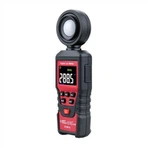How to use an oscilloscope to test a crystal oscillator
Crystal oscillators include passive crystal oscillators and active crystal oscillators. The starting waveform of the crystal oscillator can be measured with an oscilloscope. The method for measuring the crystal oscillator waveform is introduced below.
Passive crystal oscillator uses oscilloscope to measure waveform
When the passive crystal oscillator starts oscillating, both pins will generate oscillation waveforms. Connect the negative pole of the oscilloscope probe to GND and the positive pole to any crystal oscillator pin to see the waveform of the crystal oscillator.
Under normal circumstances, the waveform of the passive crystal oscillator is a sine wave. The sine waveform can be seen through an oscilloscope. The measured frequency should be consistent with the starting frequency of the crystal oscillator.
Active crystal oscillator uses oscilloscope to measure waveforms
Generally, the active crystal oscillator has four pins, two power supply pins, one output pin, and the other pin is left floating or connected to GND. When measuring, you need to connect the positive pole of the oscilloscope probe to the output pin and the negative pole to GND. There are two waveforms output by the active crystal oscillator: sine wave and square wave. This mainly depends on whether the crystal oscillator has an integrated shaping circuit. If there is a shaping circuit inside, it will output a square wave, otherwise it will output a sine wave.
Things to note when measuring
When measuring the crystal oscillator waveform, you must pay attention to two things: 1) the bandwidth of the oscilloscope; 2) the load capacitance. The bandwidth of the oscilloscope must be higher than the starting frequency of the crystal oscillator, at least 5 times, otherwise the measured waveform will be distorted. The crystal oscillator is relatively sensitive to the load capacitance, so the impact of the input capacitance on the measurement should be minimized when measuring.
Steps for using an oscilloscope to observe electrical signal waveforms.
1.Select the Y-axis coupling method
According to the frequency of the signal being measured, set the Y-axis input coupling mode selection "AC-ground-DC" switch to AC or DC.
2. Select Y-axis sensitivity
According to the approximate peak-to-peak value of the measured signal (if an attenuation probe is used, it should be divided by the attenuation multiple; when the coupling mode is in the DC gear, the superimposed DC voltage value should also be considered), select the Y-axis sensitivity V/div switch (or Y-axis attenuation switch) is set to the appropriate level. If you do not need to read the measured voltage value in actual use, you can appropriately adjust the Y-axis sensitivity fine-tuning (or Y-axis gain) knob to display the waveform with the required height on the screen.
3. Select the trigger (or synchronization) signal source and polarity
Usually the trigger (or synchronization) signal polarity switch is placed in the " " or "-" position.
4.Select scanning speed
Set the X-axis scanning speed t/div (or scanning range) switch to the appropriate level based on the approximate value of the period (or frequency) of the signal being measured. If there is no need to read the test time value in actual use, the sweep speed t/div fine-tuning (or scan fine-tuning) knob can be appropriately adjusted so that the waveform of the required number of cycles for the test can be displayed on the screen. If what needs to be observed is the edge part of the signal, the sweep speed t/div switch should be set to the fastest sweep speed.
5. Input the signal to be measured
After the measured signal is attenuated by the probe (or directly input by the coaxial cable without attenuation, but at this time the input impedance decreases and the input capacitance increases), it is input into the oscilloscope through the Y-axis input terminal.






